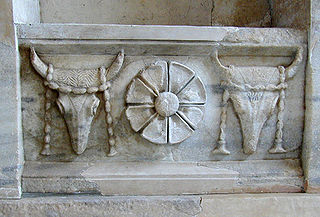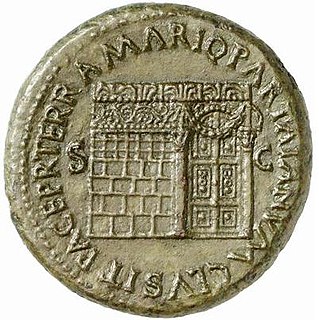
In Ancient Roman architecture, a basilica is a large public building with multiple functions, typically built alongside the town's forum. The basilica was in the Latin West equivalent to a stoa in the Greek East. The building gave its name to the architectural form of the basilica.

The Roman Forum, also known by its Latin name Forum Romanum, is a rectangular forum (plaza) surrounded by the ruins of several important ancient government buildings at the center of the city of Rome. Citizens of the ancient city referred to this space, originally a marketplace, as the Forum Magnum, or simply the Forum.

In ancient Roman religion, Concordia is the goddess who embodies agreement in marriage and society. Her Greek equivalent is usually regarded as Harmonia, with musical harmony a metaphor for an ideal of social concord or entente in the political discourse of the Republican era. She was thus often associated with Pax ("Peace") in representing a stable society. As such, she is more closely related to the Greek concept of homonoia, which was also represented by a goddess.

The Basilica Julia was a structure that once stood in the Roman Forum. It was a large, ornate, public building used for meetings and other official business during the Roman Empire. Its ruins have been excavated. What is left from its classical period are mostly foundations, floors, a small back corner wall with a few arches that are part of both the original building and later Imperial reconstructions and a single column from its first building phase.

The Temple of Caesar or Temple of Divus Iulius, also known as Temple of the Deified Julius Caesar, delubrum, heroon or Temple of the Comet Star, is an ancient structure in the Roman Forum of Rome, Italy, located near the Regia and the Temple of Vesta.

The Basilica Aemilia was a civil basilica in the Roman Forum, in Rome, Italy. Today only the plan and some rebuilt elements can be seen. The Basilica was 100 meters (328 ft) long and about 30 meters (98 ft) wide. Along the sides were two orders of 16 arches, and it was accessed through one of three entrances.

Bucranium was a form of carved decoration commonly used in Classical architecture. The name is generally considered to originate with the practice of displaying garlanded, sacrificial oxen, whose heads were displayed on the walls of temples, a practice dating back to the sophisticated Neolithic site of Çatalhöyük in eastern Anatolia, where cattle skulls were overlaid with white plaster.

A forum was a public square in a Roman municipium, or any civitas, reserved primarily for the vending of goods; i.e., a marketplace, along with the buildings used for shops and the stoas used for open stalls. Many fora were constructed at remote locations along a road by the magistrate responsible for the road, in which case the forum was the only settlement at the site and had its own name, such as Forum Popili or Forum Livi.

The Basilica Ulpia was an ancient Roman civic building located in the Forum of Trajan. The Basilica Ulpia separates the temple from the main courtyard in the Forum of Trajan with the Trajan's Column to the northwest. It was named after Roman emperor Trajan whose full name was Marcus Ulpius Traianus.

The Temple of Janus stood in the Roman Forum near the Basilica Aemilia, along the Argiletum. It was a small temple with a statue of Janus, the two-faced god of boundaries and beginnings inside. Its doors were known as the "Gates of Janus", which were closed in times of peace and opened in times of war. There are many theories about its original purpose; some say that it was a bridge over the Velabrum, and some say it functioned as a gate to the Capitoline.

The Basilica of Maxentius and Constantine, sometimes known as the Basilica Nova—meaning "new basilica"—or Basilica of Maxentius, is an ancient building in the Roman Forum, Rome, Italy. It was the largest building in the Forum, and the last Roman basilica built in the city.
The Basilica Fulvia was a basilica built in ancient Rome. According to Livy (40.51), the censors M. Aemilius Lepidus and M. Fulvius Nobilior had it built in 179 BC. It may be that there had been a previous building existing on the site from 210 BC which was incorporated. In 78 BC, the consul M. Aemilius Lepidus incorporated the building into the Basilica Aemilia, and it was renamed the Basilica Fulvia et Aemilia or sometimes simply the Basilica.

The basilica of Santi Cosma e Damiano is a titular church in Rome, Italy. The lower portion of the building is accessible through the Roman Forum and incorporates original Roman buildings, but the entrance to the upper level is outside the Forum. The circular building located at the entrance of the Forum, which now houses a small archeological exhibit, was built in the early 4th century as a Roman temple. It is thought to have been dedicated to Valerius Romulus, deified son of the emperor Maxentius. The main building was perhaps the library of an imperial forum.

The Argiletum was a street in ancient Rome, which crossed the popular district of Suburra up to the Roman Forum, along the route of the current Via Leonina and Via della Madonna dei Monti.

The Basilica Sempronia was a structure in the Roman Forum during the Republican period. It was one of four basilicas to make up the original Roman Forum alongside the Basilica Porcia, Basilica Aemilia, and Basilica Opimia, and was the third built. Although excavations have revealed remains of the basilica as well as the structures that originally stood in its place, none of them are visible from the Roman Forum.

The Regio IV Templum Pacis is the fourth regio of imperial Rome, under Augustus's administrative reform. Regio IV took its name from the Temple of Peace built in the region by the emperor Vespasian. It includes the valley between the Esquiline and the Viminal hills, the popular area of the Subura, and the Velian Hill.

The Regio VIII Forum Romanum Magnum is the eighth regio of imperial Rome, under Augustus's administrative reform. Regio VIII took its name from the Roman Forum, the political centre of Ancient Rome.















